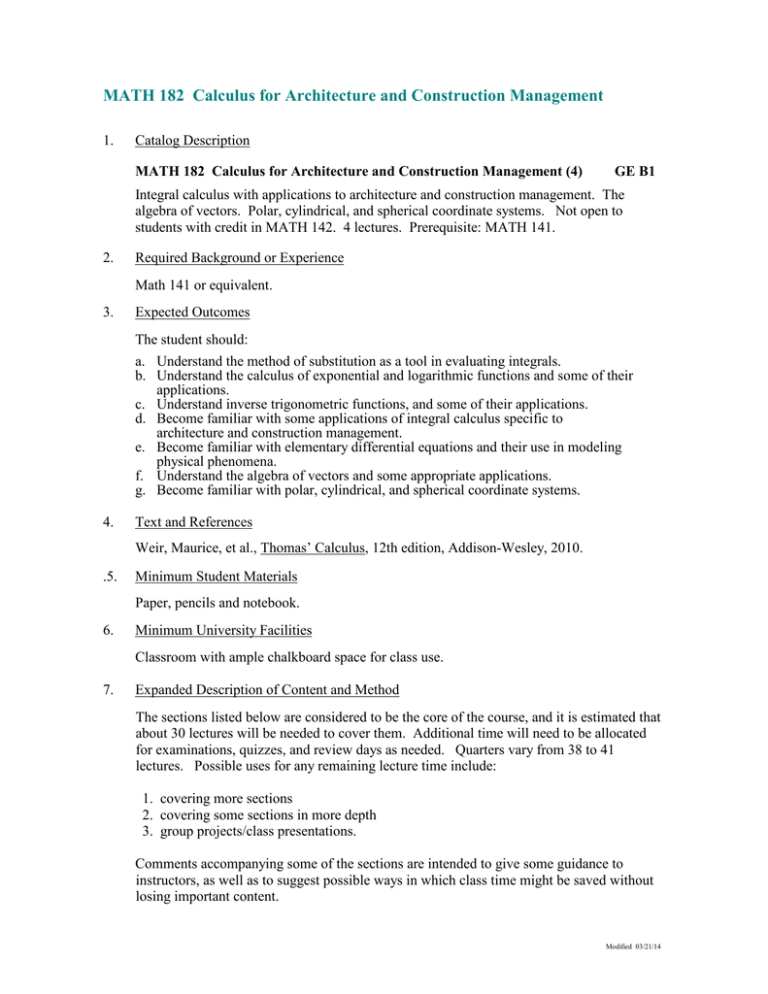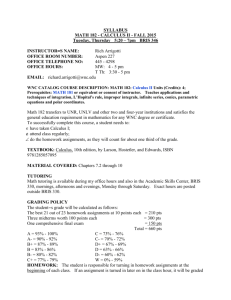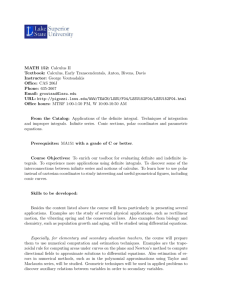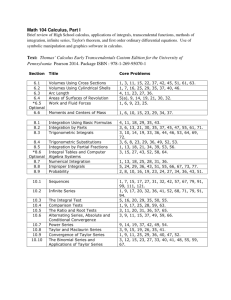MATH 182 Calculus for Architecture and Construction Management
advertisement

MATH 182 Calculus for Architecture and Construction Management 1. Catalog Description MATH 182 Calculus for Architecture and Construction Management (4) GE B1 Integral calculus with applications to architecture and construction management. The algebra of vectors. Polar, cylindrical, and spherical coordinate systems. Not open to students with credit in MATH 142. 4 lectures. Prerequisite: MATH 141. 2. Required Background or Experience Math 141 or equivalent. 3. Expected Outcomes The student should: a. Understand the method of substitution as a tool in evaluating integrals. b. Understand the calculus of exponential and logarithmic functions and some of their applications. c. Understand inverse trigonometric functions, and some of their applications. d. Become familiar with some applications of integral calculus specific to architecture and construction management. e. Become familiar with elementary differential equations and their use in modeling physical phenomena. f. Understand the algebra of vectors and some appropriate applications. g. Become familiar with polar, cylindrical, and spherical coordinate systems. 4. Text and References Weir, Maurice, et al., Thomas’ Calculus, 12th edition, Addison-Wesley, 2010. .5. Minimum Student Materials Paper, pencils and notebook. 6. Minimum University Facilities Classroom with ample chalkboard space for class use. 7. Expanded Description of Content and Method The sections listed below are considered to be the core of the course, and it is estimated that about 30 lectures will be needed to cover them. Additional time will need to be allocated for examinations, quizzes, and review days as needed. Quarters vary from 38 to 41 lectures. Possible uses for any remaining lecture time include: 1. covering more sections 2. covering some sections in more depth 3. group projects/class presentations. Comments accompanying some of the sections are intended to give some guidance to instructors, as well as to suggest possible ways in which class time might be saved without losing important content. Modified 03/21/14 Math 182, page 2. Content Lectures CHAPTER 5 – INTEGRATION 3 5.5 Indefinite Integrals and the Substitution Method (emphasize substitution) 5.6 Substitution and Area Between Curves CHAPTER 6 – APPLICATIONS OF DEFINITE INTEGRALS 6.1 Volumes Using Cross-Sections 6.2 Volumes Using Cylindrical Shells 6.3 Arc Length 6.4 Areas of Surfaces of Revolution 6.5 Work and Fluid Forces 6.6 Moments and Centers of Mass 12 CHAPTER 7 –TRANSCENDENTAL FUNCTIONS 7.1 Inverse Functions and Their Derivatives 7.2 Natural Logarithms 7.3 Exponential Functions 7.6 Inverse Trigonometric Functions (algebraic properties only) CHAPTER 9 – 9.1 7.4 9.4 FIRST-ORDER DIFFERENTIAL EQUATIONS Solutions, Slope Fields, and Euler’s Method (skip Euler’s Method) Exponential Change and Separable Differential Equations Graphical Solutions of Autonomous Equations (Optional) 7 3 CHAPTER 11 – PARAMETRIC EQUATIONS AND POLAR COORDINATES 11.3 Polar Coordinates 11.4 Graphing in Polar Coordinates 2 CHAPTER 12 – VECTORS AND THE GEOMETRY OF SPACE 12.1 Three-Dimensional Coordinate Systems 12.2 Vectors 2 CHAPTER 15 – MULTIPLE INTEGRALS 15.7 Triple Integrals in Cylindrical and Spherical Coordinates (only cover the definitions of the two coordinate systems) 1 ____ Total 30 Remarks: a. The pacing of Math 182 is more relaxed than in Math 142, allowing for an increased emphasis on applications of integral calculus. b. Instructors should expect to spend about five days combined on sections 6.5 and 6.6. c. The selected topics from section 7.6 and chapters 11,12, and 15 will not involve calculus. Math 182, page 3. 8. Methods of Assessment The primary methods of assessment are, in decreasing order of importance: essay examinations, quizzes and homework. Typically, there will be two or three hour-long examinations during the quarter, and a comprehensive final examination. Students are required to show their work, and are graded not only on the correctness of their answers, but also on their understanding of the concepts and techniques. Quizzes are sometimes given once or twice a week to provide a spot check of student learning. Homework is required daily. Since this class satisfies a General Education requirement, at least 10% of the course grade must be based on student writing using correct mathematical notation.




